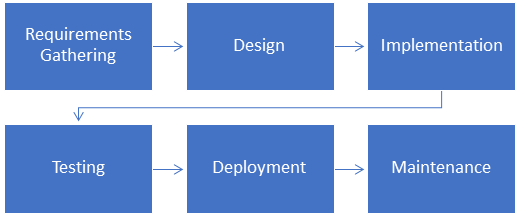The Waterfall project management methodology is a sequential project management approach that is utilized across various projects. This method is a linear, step-by-step process with a strong emphasis on the documentation that requires the completion of each phase before moving to the next. It offers advantages such as clear milestones, well-defined scope and structured planning, but also possesses certain limitations, including an inflexibility to handle change and limited client involvement. The Waterfall project management methodology is best suited for projects with well-defined requirements that are unlikely to change significantly as alterations and adaptations can prove difficult and costly.
Let’s take a quick look at the steps in waterfall methodology:
- Requirements Gathering: Clearly defining and documenting the project’s requirements.
- Design: Creating detailed plans and designs based on the gathered requirements.
- Implementation: The actual development or construction of the project based on design specifications.
- Testing: Conducting thorough testing to identify and fix any issues or defects.
- Deployment: Rolling out the final product to users or customers.
- Maintenance: Ongoing support and maintenance of the product after deployment.

Advantages and Disadvantages of Waterfall Methodology
The Waterfall method offers several benefits, particularly in projects with well-defined and stable requirements. Its structured and sequential approach provides a clear roadmap, allowing for efficient planning and estimating project timelines and budgets. The use of comprehensive documentation throughout each phase ensures that decisions and project history are well-recorded for future reference. Additionally, a formal sign-off process at the end of each stage keeps stakeholders involved in critical decision-making, ensuring their satisfaction with progress before moving forward. The Waterfall method benefits small projects with straightforward requirements as it minimizes management overhead. This approach is best suited where changes are minimal, providing a controlled and predictable project management process.
The Waterfall project management methodology boasts wide popularity in large and small institutions. According to a report by the Project Management Institute in 2021, about 59% of traditional organizations use a waterfall approach to project management, while approximately 22% use an agile and 16% a hybrid approach. With its structured and easy-to-use approach, it is no surprise that this project management method is the most popular among traditional organizations.
Despite its merits, the Waterfall methodology does have significant shortfalls that have led to its decreasing popularity in certain contexts. One of the major drawbacks is its lack of flexibility. The method’s rigid sequential nature makes accommodating changes or responding to evolving requirements challenging. Late error detection is another concern that could potentially lead to costly and time-consuming fixes since testing and validation occur toward the end of the project. Limited client involvement during development can also create a disconnect between expectations and the final product.
Moreover, the long duration of waterfall projects and the risk of technology obsolescence can make this method less suitable for fast-paced and dynamic industries. The high cost of implementing changes after moving into later stages and the dependency on accurate initial requirements are additional critical shortfalls. These limitations have spurred the adoption of more adaptive and responsive methodologies, like Agile Project Management, that can better address the complexities and uncertainties of modern projects.
Ultimately, the Waterfall project management methodology remains an enduring and widely recognized project management approach. Its traditional, step-by-step nature and emphasis on documentation provide a well-defined path for project execution. Like any tool, the Waterfall Method has its limitations that may steer project managers toward more flexible methodologies, but in the end, the choice between the Waterfall methodology and more agile alternatives will depend on the unique characteristics and demands of each project.
Author: Bridget Vaughey | [email protected]
Contact Us
Starting a complex project soon? Let our Business and Management Consulting Team guide you through the process. With our extensive experience in project management, we can help you choose the right methodology and ensure your project is a success.




